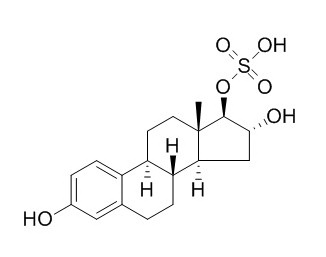Estriol 17-sulfate
Estriol 17-sulfate stimulates PR very significantly in the MCF-7 human mammary cancer cell line E3 and E3-3-S.
Inquire / Order:
manager@chemfaces.com
Technical Inquiries:
service@chemfaces.com
Tel:
+86-27-84237783
Fax:
+86-27-84254680
Address:
1 Building, No. 83, CheCheng Rd., Wuhan Economic and Technological Development Zone, Wuhan, Hubei 430056, PRC
Providing storage is as stated on the product vial and the vial is kept tightly sealed, the product can be stored for up to
24 months(2-8C).
Wherever possible, you should prepare and use solutions on the same day. However, if you need to make up stock solutions in advance, we recommend that you store the solution as aliquots in tightly sealed vials at -20C. Generally, these will be useable for up to two weeks. Before use, and prior to opening the vial we recommend that you allow your product to equilibrate to room temperature for at least 1 hour.
Need more advice on solubility, usage and handling? Please email to: service@chemfaces.com
The packaging of the product may have turned upside down during transportation, resulting in the natural compounds adhering to the neck or cap of the vial. take the vial out of its packaging and gently shake to let the compounds fall to the bottom of the vial. for liquid products, centrifuge at 200-500 RPM to gather the liquid at the bottom of the vial. try to avoid loss or contamination during handling.
J Pharm Biomed Anal.2016, 129:50-59
Molecules.2021, 26(2):E255.
Preprints2022, 2022030063.
Food Chem.2019, 276:768-775
Sains Malaysiana2024, 53(2):397-408.
J Microbiol Biotechnol.2024, 35:e2408022.
Molecules.2018, 23(7):E1817
J Food Sci.2022, 87(11):4905-4916.
Molecules.2019, 24(9):E1719
J Pharm Biomed Anal.2022, 207:114398.
Related and Featured Products
J Steroid Biochem. 1986 Jan;24(1):357-9.
Effect of estriol, estriol-3-sulfate and estriol-17-sulfate on progesterone and estrogen receptors of MCF-7 human breast cancer cells.[Pubmed:
3702418]
METHODS AND RESULTS:
The levels of progesterone receptors (PR [cytosol (Cy) and nuclear (N)] and estrogen receptors (ER) [cytosol and nuclear; occupied and unoccupied specific binding sites] were evaluated in the MCF-7 cancer cell line incubated with estriol (E3), estriol-3-sulfate (E3-3-S) or Estriol 17-sulfate (E3-17-S) for 7 days in culture. Cells were grown in MEM medium containing 2 mM glutamine, 10% v/v dialysed calf serum and penicillin-streptomycin (100 U/ml) in the absence (control) or in the presence of 5 X 10(-8) M E3, E3-3-S or Estriol 17-sulfate. The total PR (Cy + N) concentration which was 0.47 +/- 0.10 (SE) pmol/mg DNA in the non-treated cells, increased to 1.95 +/- 0.48 in the E3 and to 1.55 +/- 0.26 in the E3-3-S treated cells. No effect (PR: 0.47 +/- 0.15 pmol/mg DNA) was observed with the Estriol 17-sulfate treatment. Total ER (Cy + N, occupied + unoccupied binding sites) in pmol/mg DNA +/- SE, were as follows: control 0.79 +/- 0.17; + E3: 0.33 +/- 0.09; +E3-3-S: 0.90 +/- 0.18 and +Estriol 17-sulfate: 1.82 +/- 0.58. The measurement by radioimmunoassay of unconjugated estriol in the culture medium indicated that after incubation with E3-3-S, a fraction (0.5-1%) of the sulfate was hydrolyzed but no hydrolysis was observed in the incubations with E3-17-S.
CONCLUSIONS:
It is concluded that in the MCF-7 human mammary cancer cell line E3 and E3-3-S stimulate PR very significantly, but it is suggested that E3-3-S acts through the hydrolyzed E3. On the other hand, Estriol 17-sulfate is inactive because it is not hydrolyzed. Consequently, E3-3-S can play an important role in the biological responses of this mammary cancer cell line.
Eur J Cancer Clin Oncol. 1986 Dec;22(12):1495-501.
Biological effects and morphological responses to estriol, estriol-3-sulfate, estriol-17-sulfate and tamoxifen in a tamoxifen-resistant cell line (R-27) derived from MCF-7 human breast cancer cells.[Pubmed:
3595675]
The R-27 cell line is a variant clone derived from the MCF-7 human breast cancer cell line which has lost its inhibitory response to anti-estrogens.
METHODS AND RESULTS:
In the present study, we have compared the biological responses to estriol (E3), estriol-3-sulfate (E3-3-S), and Estriol 17-sulfate (E3-17-S) in these cells and in the parent MCF-7 cells. In the R-27 cell line after 7 days of culture, the progesterone receptor (PR) concentrations were greatly increased by E3 and E3-3-sulfate; however, tamoxifen did not block this effect. The effect in PR provoked by Estriol 17-sulfate was significantly less intense. The concentrations of PR (pmol/mg DNA +/- S.D.) in the R-27 cells were as follows: control: 1.1 +/- 0.8; +E3: 10.5 +/- 2.4; +E3-3-S: 5.4 +/- 2.3; +E3-17-S: 2.6 +/- 0.8. E3 and E3-3-S also stimulated PR in the MCF-7 cells but to a lesser extent. No stimulation was observed in the Estriol 17-sulfate treatment. A fraction (0.5-1%) of the E3-3-S was found to be hydrolysed in the medium during the incubation in both cell lines, but no hydrolysis occurred after incubation with Estriol 17-sulfate. Ultrastructural observations showed that in the E3 and E3-3-S treated cells, there was an important development of the ergastoplasm, bundles of filaments and an accumulation of ribosomes. No significant morphological alteration was observed in cells exposed to E3-17-S.
CONCLUSIONS:
In conclusion, E3 is biologically very active in both the R-27 and the MCF-7 cell lines and estriol 3-sulfate could play a role in the control of the estrogenic activity of E3.



